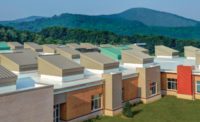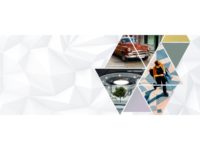Demand for coated metal in applications and segments like metal roofing and building and construction is rising exponentially, fueled by a global boom in commercial, residential and industrial construction and renovation activity.
Durable, high-quality coil and extrusion coatings for exterior applications offer excellent protection against weathering, sun exposure, chemicals, heat and other harsh outdoor elements. They are also more sustainable, which is an increasingly important factor as industries look to reduce their carbon footprints by utilizing bio-renewable, sustainable and energy efficient materials and processes. For example, our CERAM-A-STAR® 1050 coil coating system can be used with our COOL CHEMISTRY® technology, which contains infrared reflective pigments. These pigments are designed to reflect infrared energy while still absorbing visible light energy, so they stay cooler.
There is growing awareness of the opportunities and benefits of using coated metals for other applications, too, such as metal roofing or monumental projects that use aluminum composite panels. In addition, we are seeing growing demand for a targeted portfolio of colors that coaters and distributors can supply to specifiers and architects that enable quicker turnarounds on projects and improved efficiencies for their businesses.
Like most sectors, the coatings industry was affected by the restrictions and uncertainties of the pandemic, but it has emerged stronger and more resilient. Demand for certain coatings and their end-use products rose during the crisis. In North America and Europe, the strength of the construction and residential housing market ensured demand for our products remained high as lockdown restrictions lifted.
Of course, many challenges still remain. All sectors of the coatings industry have been hit by extreme global raw material shortages and supply disruptions - often interrupting supply chains. Raw material, packaging and transportation costs are rising, and the availability of labor is tight resulting in unprecedented inflationary impacts. We continue to work with our customers and help them navigate this difficult landscape.
Technologies That Look Newer for Longer
The growth in demand for metal coatings has been accompanied by a growth in expectations. Architects, designers, and end-users are looking for coating technologies that look newer for longer, ensuring that a structure looks as good in five, 10 or 20 years’ time as it did when it was first built. This is why we invest so much time and resources in our testing and weathering program. For decades, we have been testing our coil and extrusion coatings at weathering facilities in South Florida and other locations around the world. Our real-world exposure program is the largest in the industry, with over 40,000 panels in South Florida alone. We regularly review and evaluate our test panels to make sure we understand and can predict how they will perform across the fullest range of weather conditions.
Advances in resin and formulation technologies continue to improve and are reaching ever higher standards. We have proven technologies that can hold color and gloss retention for decades, and in areas like aluminum composite panels or metal roof applications, coated metal stands up much longer than other alternative substrate or material options. We are looking at alternative technologies with greater availability to provide high performance solutions with reduced carbon footprint and improved supply chain stability.
Industry Trends
When it comes to color, we are seeing two opposing trains of thought. On one side, consolidating color palettes brings efficiencies for the coater and distributor. But on the flip side, architects and designers are looking to customize projects with specialty appearances like textures or dark colors, such as the ‘rural builder’ trend in residential trim, roofs and doors. Matching entire building envelope (coil and extrusion) appearance and performance is key to a successful project.
Energy efficiency and sustainability are two trends that continue to grow in value and importance in both residential and public use structures. Formulation technologies that can drive down energy usage by keeping a building cooler through thermal reflective pigments are increasingly popular. Our COOL CHEMISTRY® products for roofing applications, for example, utilize ceramic and inorganic infrared reflective pigments to absorb visible light energy while reflecting heat. The result is a sustainable building material that can lower air conditioning costs by up to 15% in hot climates and reduce peak energy demand.
Sustainability has long been an important part of the way we do business, and we take our responsibilities seriously. We are continually exploring how our paints can contribute toward energy efficiency, reduce our carbon footprint, and make use of bio-renewable materials. We have set carbon reduction targets for our whole value chain, which have been validated by the Science Based Targets initiative (SBTi) – the first paints and coatings company to receive this endorsement.
Trends can be hard to predict; they evolve over time. Specifiers need to consider not only the appearance and popularity of a trend today, but how it will evolve with time and what impact that may have on the resale value for the owner/occupier further down the line.
Apps and other digital tools that can help architects and specifiers visualize colors, textures and other details in a proposed build more clearly are becoming more important. Our Canopy app, for example, makes it easy to find the perfect coating for pre-painted metal application. It simplifies the color selection process, gives customers the ability to search our extensive database of products, and includes other helpful tools such as calculators and a document library.
Optimizing Durability
Our most popular products are resin-based coating technologies. For building products, these are typically silicone-modified polyester (SMP) or polyvinylidene fluoride (PVDF) resins which are strong, stable, corrosion and temperature resistant and have superior color and gloss retention. These provide excellent protection against weathering, sun exposure, heat and other harsh outdoor elements.
Application and attention to detail are the key to achieving a long-lasting finish. We recommend checking with your coater regarding how they plan to prepare the substrate and how they will adhere to preparation standards to ensure a quality coating. It is also worth asking about the coating being used and the type of formulation, as well as what you can expect in terms of performance and the type of warranty provided.
It is also important to understand how best to maintain the coating once it is on the building. These are all important conversations to have with your provider. To avoid issues during installation, make sure your contractor follows the installations steps, paying particular attention to ventilation, layering of the proper materials and the type of fasteners used, to ensure the coating remains in its best condition for the life of the building.
Committed to the Future
It is an exciting time to be in the metal coatings industry. After a period of global uncertainty that affected most industries, the construction and building sectors are growing once more, demand for high quality, durable and sustainable coatings products is increasing, and advances in technologies are driving new levels of innovation in applications and performance.
Working in this sector offers a unique chance to be part of something enduring, helping to create beautiful and iconic buildings that will leave a lasting mark on the world. This is what drives us at AkzoNobel. It underpins our commitment to investment, and it lies at the heart of our determination to provide the best possible products, services and support to our customers and end-users.
-REV-web.jpg?1656689303)


.jpg?height=200&t=1663088625&width=200)